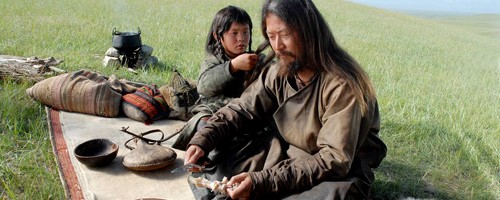Being an intelligent college student, I’m sure you know that Genghis Khan conquered China’s Xin and Jin Dynasties in the 13th century. I’m sure you’re also criticizing me for oversimplifying the Mongol invasion of the landmasses currently known as China and Russia.
Genghis Kahn, feminist
Being an intelligent college student, I’m sure you know that Genghis Khan conquered China’s Xin and Jin Dynasties in the 13th century. I’m sure you’re also criticizing me for oversimplifying the Mongol invasion of the landmasses currently known as China and Russia.
But what you maybe never considered is how it really was a lot of work to conquer a couple of large empires in perhaps the most technologically advanced area of the 13th century world. Sergei Bodrov’s Mongol: The Rise of Genghis Khan (2007) makes this improbable feat seem as impressive as it probably was in real life.
You already know that Genghis was a man whose bloodthirstiness is now legendary. Did you ever think that he was once an innocent child? He was. And like most unrepentantly murderous adults, childhood was pretty rough for him.
That’s where we find little Temudgin, traveling across the steppe with his father to select his bride-to-be. He’s a cute little rascal—proud, contrary, cunning and proto-feminist.
Come again!? You read correctly. Unlike most Mongols of the day, Tamudgin lets his wife, Borte, select him. His first battle involves enlisting his blood-brother, Jamukha, to help recover Borte from a rival tribe. Afterward, Jamukha demands: “Don’t tell anyone we went to war over a woman.”
Rescuing a woman isn’t feminist? True, true. But don’t fret: Borte can hold her own even when Tamudgin does hard time in a Chinese prison. And then she rescues him.
Fussy quibbling about the likely social dynamics of a nomadic, war-like ancient ethnic group aside, this film is damn powerful. Some critics have taken issue with the film—probably because it’s so incredibly badass. And gorgeous.
The scenery is unbeatable. Long, panoramic shots of the Mongolian steppe—actually shot in current day Kazakhstan and inner Mongolia, a Chinese province—Mongolian warriors scramble up and down grassy hills and through the occasional conifer forest.
There is lots of water; water in lakes, in rivers, in marshes. (One wonders what a nonresident Mongolian fishing license costs.) The small screen cannot possibly do this film justice: The big screen will be immeasurably better, and the IMAX would be better still.
To capture the often subtle beauty of this complex landscape, Sergey Trofimov’s cinematography runs the gamut from hyper-saturated red-tinged faces and costumes, to blue filtered sky and conifer forests, to sun-bleached sand. Every shot is engineered for maximum aesthetic engagement.
As a result, the blood is impossibly crimson. It flows like water. It freezes in midair; splats and sprays coat friend and foe alike. At times, the battle scenes become nearly as comical as an old Sam Raimi or Peter Jackson splatterfest, as one bloody burst after another issues forth from warriors’ wounds. The violence is never-ending. It always has consequences, and those consequences are invariably more violence.
Is there something here about the futility of blood feuds? Not at all.
The predominant theme is lawful social order and the breakdown thereof. We learn that Tamudgin lives in a time when Mongols have increasingly little respect for customs and laws—there may be no difference here—and his mission is to teach that respect. As his father says, right before he’s shamelessly murdered by a rival clan: “If I, Kahn Esugei, start breaking customs, the world will turn upside down.”
Tamudgin responds to this state of affairs thusly: “Mongols need laws. I’ll teach them to obey— even if I have to kill half of them.”
And he may. Tamudgin is always in the thick of the bloodbath. He fights ceaselessly. He’s willful and headstrong, as a successful old world conqueror would have to be. For his stubbornness, he’s kidnapped and held prisoner time and again. It gets a little exasperating.
As we well know, Tamudgin becomes a legend. The film imagines the providential occurrences predicating that legend. Every moment is fraught with meaning. Old men predict greatness or warn of catastrophe depending on what side they’re on. Even Tamudgin taking a piss is depicted as a moment of great historical significance.
How does one man repeatedly escape death by the skin of his teeth, ally the factious tribes of central Asia and go on to conquer the better part of the Eastern world in his lifetime? With help from the supernatural, of course.
There’s magical realism here, and some viewers may find it distracts from the film’s historical authenticity, which the film’s site claims it has in spades. I tend to like it. It’s generally subtle enough that it can be explained away as serendipity if one wishes, but it really adds to the film’s historical aura. The film takes place in pre-Buddhist Mongolia. The people were shamanistic and they believed in magic. The power of magical realism is that it depicts the world as the ancient Mongols would have experienced it.
It’s a world where a thunderstorm isn’t just a thunderstorm; where a crevice in the rock is a sacred place and a wolf can appear as an emissary from God. It’s a world of raw beauty, and the wide-open landscape appears simultaneously soulfully liberating and threateningly sublime.
It’s a world of honor and love and unrelenting violence. It’s a world gone forever (thanks in no small part to Maoist China), but whose essence has been skillfully re-imagined and recast by Bodrov, with the help of the current day Kazakhs and Mongolians.
Mongol: The Rise of Genghis Kahn (2007)
Friday, April 27, at 7 and 9:30 p.m.
Saturday, April 28, at 7 and 9:30 p.m.
Sunday, April 29, at 3 p.m.
Free for PSU students and faculty;
$2 all other students and seniors;
$3 general admission





